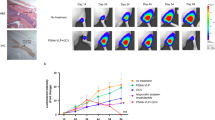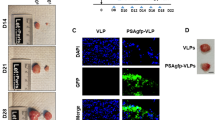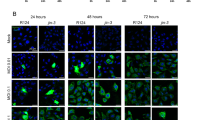Abstract
We previously constructed OBP-301 (Telomelysin, a telomerase-specific replication-competent adenovirus with human telomerase reverse transcriptase (hTERT) promoter), which showed a strong anticancer effect by inducing cell lysis of human non-small cell lung cancer and colorectal cancer cells. To investigate the utility of OBP-301 for prostate cancer treatment, we herein evaluate the cell killing and antitumor effects. First, in vitro hTERT-specific adenovirus transduction in human prostate cancer cells (LNCaP, PC3, DU145) was confirmed using OBP-401 (Telomelysin-green fluorescent protein (GFP)). There was no detectable GFP transduction in the human prostate normal cells (PrEC, PrSC). Consistently, the cell-killing effect of OBP-301 was observed only in the cancer cells. Second, using an in vivo subcutaneous LNCaP tumor model in nude mice, we demonstrated that three intratumoral OBP-301 injections (107 PFU per tumor × 3 days) were sufficient to eradicate the detectable LNCaP prostate tumor. We also demonstrated that the ispilateral treatment with OBP-301 significantly suppressed contralateral LNCaP tumor growth in both sides of the tumor model. Histological and immunohistochemical analyses revealed diffuse oncolytic degeneration and adenoviral E1A protein expression in both sides of the tumors. Therefore, in situ OBP-301 administration could be a promising therapeutic strategy against prostate cancer and its metastatic lesions.
This is a preview of subscription content, access via your institution
Access options
Subscribe to this journal
Receive 12 print issues and online access
$259.00 per year
only $21.58 per issue
Buy this article
- Purchase on Springer Link
- Instant access to full article PDF
Prices may be subject to local taxes which are calculated during checkout





Similar content being viewed by others
References
Jemal A, Murray T, Ward E, Samuels A, Tiwari RC, Ghafoor A et al. Cancer statistics, 2005. CA Cancer J Clin 2005; 55: 10–30.
Gdor Y, Timme TL, Miles BJ, Kadmon D, Thompson TC . Gene therapy for prostate cancer. Expert Rev Anticancer Ther 2002; 2: 309–321.
Nasu Y, Saika T, Ebara S, Kusaka N, Kaku H, Abarzua F et al. Suicide gene therapy with adenoviral delivery of HSV-tK gene for patients with local recurrence of prostate cancer after hormonal therapy. Mol Ther 2007; 15: 834–840.
Nasu Y, Kusaka N, Saika T, Tsushima T, Kumon H . Suicide gene therapy for urogenital cancer: current outcome and prospects. Mol Urol 2000; 4: 67–71.
Blackburn EH . Structure and function of telomeres. Nature 1991; 350: 569–573.
Kim NW, Piatyszek MA, Prowse KR, Harley CB, West MD, Ho PL et al. Specific association of human telomerase activity with immortal cells and cancer. Science 1994; 266: 2011–2015.
Shay JW, Wright WE . Telomerase activity in human cancer. Curr Opin Oncol 1996; 8: 66–71.
Nakayama J, Tahara H, Tahara E, Saito M, Ito K, Nakamura H et al. Telomerase activation by hTRT in human normal fibroblasts and hepatocellular carcinomas. Nat Genet 1998; 18: 65–68.
Kawashima T, Kagawa S, Kobayashi N, Shirakiya Y, Umeoka T, Teraishi F et al. Telomerase-specific replication-selective virotherapy for human cancer. Clin Cancer Res 2004; 10: 285–292.
Umeoka T, Kawashima T, Kagawa S, Teraishi F, Taki M, Nishizaki M et al. Visualization of intrathoracically disseminated solid tumors in mice with optical imaging by telomerase-specific amplification of a transferred green fluorescent protein gene. Cancer Res 2004; 64: 6259–6265.
Taki M, Kagawa S, Nishizaki M, Mizuguchi H, Hayakawa T, Kyo S et al. Enhanced oncolysis by a tropism-modified telomerase-specific replication-selective adenoviral agent OBP-405 (‘Telomelysin-RGD’). Oncogene 2005; 24: 3130–3140.
Fujiwara T, Kagawa S, Kishimoto H, Endo Y, Hioki M, Ikeda Y et al. Enhanced antitumor efficacy of telomerase-selective oncolytic adenoviral agent OBP-401 with docetaxel: preclinical evaluation of chemovirotherapy. Int J Cancer 2006; 119: 432–440.
Watanabe T, Hioki M, Fujiwara T, Nishizaki M, Kagawa S, Taki M et al. Histone deacetylase inhibitor FR901228 enhances the antitumor effect of telomerase-specific replication-selective adenoviral agent OBP-301 in human lung cancer cells. Exp Cell Res 2006; 312: 256–265.
Kishimoto H, Kojima T, Watanabe Y, Kagawa S, Fujiwara T, Uno F et al. In vivo imaging of lymph node metastasis with telomerase-specific replication-selective adenovirus. Nat Med 2006; 12: 1213–1219.
Watanabe M, Nasu Y, Kashiwakura Y, Kusumi N, Tamayose K, Nagai A et al. Adeno-associated virus 2-mediated intratumoral prostate cancer gene therapy: long-term maspin expression efficiently suppresses tumor growth. Hum Gene Ther 2005; 16: 699–710.
Watanabe M, Kashiwakura Y, Kusumi N, Tamayose K, Nasu Y, Nagai A et al. Adeno-associated virus-mediated human IL-10 gene transfer suppresses the development of experimental autoimmune orchitis. Gene Ther 2005; 12: 1126–1132.
Ferrero JM, Chamorey E, Oudard S, Dides S, Lesbats G, Cavaglione G et al. Phase II trial evaluating a docetaxel–capecitabine combination as treatment for hormone-refractory prostate cancer. Cancer 2006; 107: 738–745.
Biroccio A, Leonetti C . Telomerase as a new target for the treatment of hormone-refractory prostate cancer. Endocr Relat Cancer 2004; 11: 407–421.
Acknowledgements
This work was supported by a grant from the Ministry of Education, Culture, Sports, Science and Technology's FY2006 ‘Creation of Innovation Centers for Advanced Interdisciplinary Research Areas’ Scheme in Japan and by a scientific research grant from the Japan Society for the Promotion of Science (C, 18591754; H Kaku). We also thank Yuka Matono, Hideo Ueki and Katsuo Ohno for their valuable technical assistance.
Author information
Authors and Affiliations
Corresponding author
Rights and permissions
About this article
Cite this article
Huang, P., Watanabe, M., Kaku, H. et al. Direct and distant antitumor effects of a telomerase-selective oncolytic adenoviral agent, OBP-301, in a mouse prostate cancer model. Cancer Gene Ther 15, 315–322 (2008). https://doi.org/10.1038/cgt.2008.3
Received:
Revised:
Accepted:
Published:
Issue Date:
DOI: https://doi.org/10.1038/cgt.2008.3
Keywords
This article is cited by
-
Systemic Management for Advanced Hepatocellular Carcinoma: A Review of the Molecular Pathways of Carcinogenesis, Current and Emerging Therapies, and Novel Treatment Strategies
Digestive Diseases and Sciences (2019)
-
MYC-dependent downregulation of telomerase by FLT3 inhibitors is required for their therapeutic efficacy on acute myeloid leukemia
Annals of Hematology (2018)
-
Telomeres and telomerase in prostate cancer development and therapy
Nature Reviews Urology (2017)
-
Oncolytic adenovirus based on serotype 3
Cancer Gene Therapy (2011)
-
Potent antitumor effects of combined therapy with a telomerase-specific, replication-competent adenovirus (OBP-301) and IL-2 in a mouse model of renal cell carcinoma
Cancer Gene Therapy (2010)



